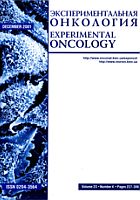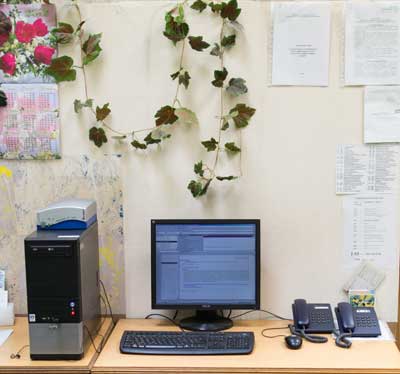
Бази даних
Наукова періодика України - результати пошуку
 |
Для швидкої роботи та реалізації всіх функціональних можливостей пошукової системи використовуйте браузер "Mozilla Firefox" |
|
|
Повнотекстовий пошук
| Знайдено в інших БД: | Реферативна база даних (2) |
Список видань за алфавітом назв: Авторський покажчик Покажчик назв публікацій  |
Пошуковий запит: (<.>A=Shton I$<.>) | |||
|
Загальна кількість знайдених документів : 2 Представлено документи з 1 до 2 |
|||
| 1. | 
Philchenkov A. A. Photodynamic responsiveness of human leukemia Jurkat/A4 cells with multidrug resistant phenotype [Електронний ресурс] / A. A. Philchenkov, E. D. Shishko, M. P. Zavelevich, L. M. Kuiava, K. Miura, D. Y. Blokhin, I. O. Shton, N. F. Gamaleia // Experimental oncology. - 2014. - Vol. 36, № 4. - С. 241-245. - Режим доступу: http://nbuv.gov.ua/UJRN/EOL_2014_36_4_7 Background: photodynamic therapy (PDT) is considered as a possible alternative approach to overcoming multidrug resistance (MDR). Analysis of cross-resistance to PDT in cells with different MDR pathways and resistance levels seems to be advantageous for elucidating the general mechanisms of cancer cell resistance to various treatment modalities. Aim - the aim of the study was to clarify whether the Jurkat/A4 leukemia cells with MDR phenotype are cross-resistant to PDT. Human T-cell acute lymphoblastic leukemia line Jurkat and Jurkat/A4 subline with MDR phenotype were used. 5-Aminolevulinic acid (ALA) and Photolon (a complex of chlorine-e6 and polyvinylpyrrolidone; PL) or gold nanocomposite of PL were applied as photosensitizers. The cells were pretreated with photosensitizers and exposed to laser radiation at corresponding wavelengths. The phototoxicity was assessed in trypan blue exclusion test. The hypodiploid cell fraction was analyzed by flow cytometry of propidium iodidestained cells. Expression of genes related to PDT resistance was analyzed by micro array technique with Affymetrix U133A chips. ALA-mediated PDT resulted in dose-dependent cell death in both lines, the relative photodynamic efficacy in Jurkat/A4 cells being inferior to that in the parental Jurkat cells. There was no correlation between phototoxicity and apoptosis induction both in Jurkat and Jurkat/A4 cells. PL-mediated general phototoxicity in Jurkat cells amounted up to 75 % at the maximal photosen-sitizer dose with about 40 % of apoptotic death fraction. PL-phototoxicity in Jurkat/A4 cells was considerably lower. In contrast to Jurkat cells, PL-gold composite did not increase the efficacy of photosensitization as compared to free PL in Jurkat/A4 cells. Conclusions: multidrug-resistant Jurkat/A4 cells exhibit reduced sensitivity to phototoxic effect in comparison with parental Jurkat cells independently of nature of the photosensitizer being assayed. | ||
| 2. | 
Shton I. O. Chlorin e6 combined with albumin nanoparticles as a potential composite photosensitizer for photodynamic therapy of tumors [Електронний ресурс] / I. O. Shton, V. V. Sarnatskaya, I. V. Prokopenko, N. F. Gamaleia // Experimental oncology. - 2015. - Vol. 37, № 4. - С. 250-254. - Режим доступу: http://nbuv.gov.ua/UJRN/EOL_2015_37_4_5 Aim - to synthesize and to study for photodynamic activity a composite photosensitizer consisting of chlorin e6 and human serum albumin nanoparticles (HSA NPs). Starting from sorption-purified HSA, the albumin nanoparticles with a different degree of lysine residues cross-linking (10; 20; 40, and 100 %) were obtained by the coacervation method. The HSA NPs were used for synthesis of nanocomposites with chlorin e6 and fluorescein isothiocyanate (FITC)-labled preparations. Malignant lymphocytes of the MT-4 (human T-cell leukemia) line and normal lymphocytes of healthy donors served as cell targets. For photodynamic treatment, a semiconductor laser was exploited as a light source, and cell viability was assessed by MTT or trypan blue dye exclusion tests. For cell imaging and HSA NPs visualization, the fluorescence microscopy and transmission electron microscopy were applied, respectively. C57BI/6 mice were used in animal experiments. The absorption and fluorescence spectra of chlorin e6-HSA NPs composites were characterized, and by the electron microscopy investigation the size of NPs (nanospheres) was estimated: 100 - 120 nm. FITC-labled albumin preparations allowed to establish that HSA NPs have much higher exposition and concentration dependent affinity to malignant cell surface than initial HSA. In experiments with MT-4 cells on PDT activity of chlorin e6-HSA NPs, the nanocomposite effectiveness elevated along with increasing percentage of cross-linked aminoacid residues, and for the nanocomposite with 100 % of albumin cross-linking it exceeded the activity of free chlorin e6. In contrast to malignant cells, the complexation of chlorin e6 with HSA NPs decreased its photodynamic effect on normal human lymphocytes. Intravenous introduction of the chlorin e6-HSA NPs composite to mice showed prolonged circulation of the nanocomposite in blood in comparison with free PS. Conclusion: promising results obtained with chlorin e6-HSA NPs composites warrant conduction of full-fledged PDT studies in vivo using the nanocomposites as photosensitizers. | ||
 |
| Відділ наукової організації електронних інформаційних ресурсів |
 Пам`ятка користувача Пам`ятка користувача |